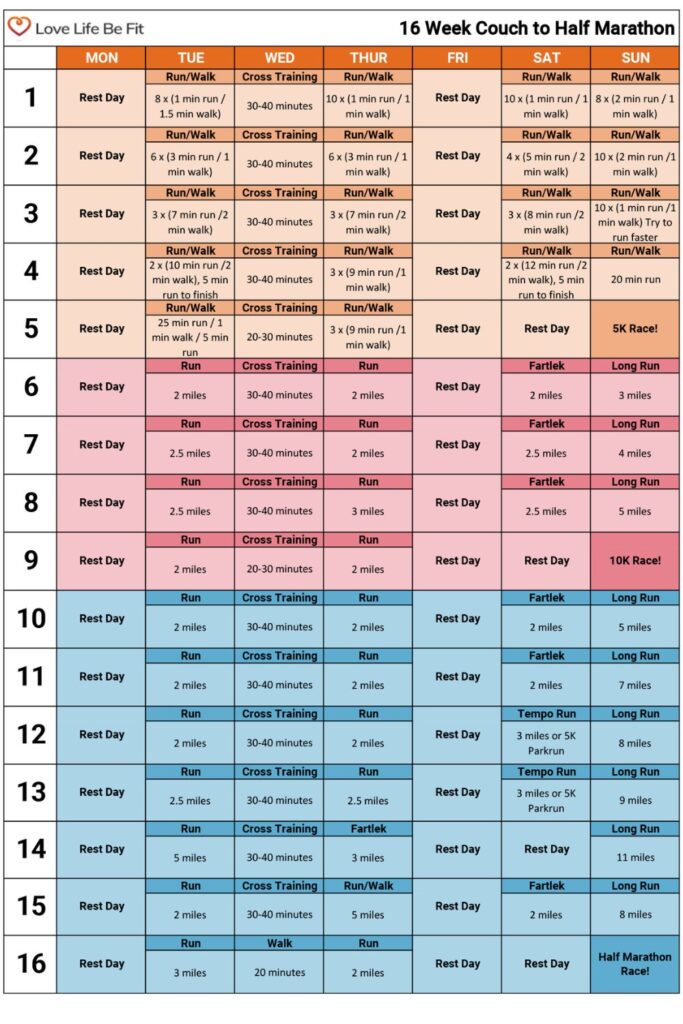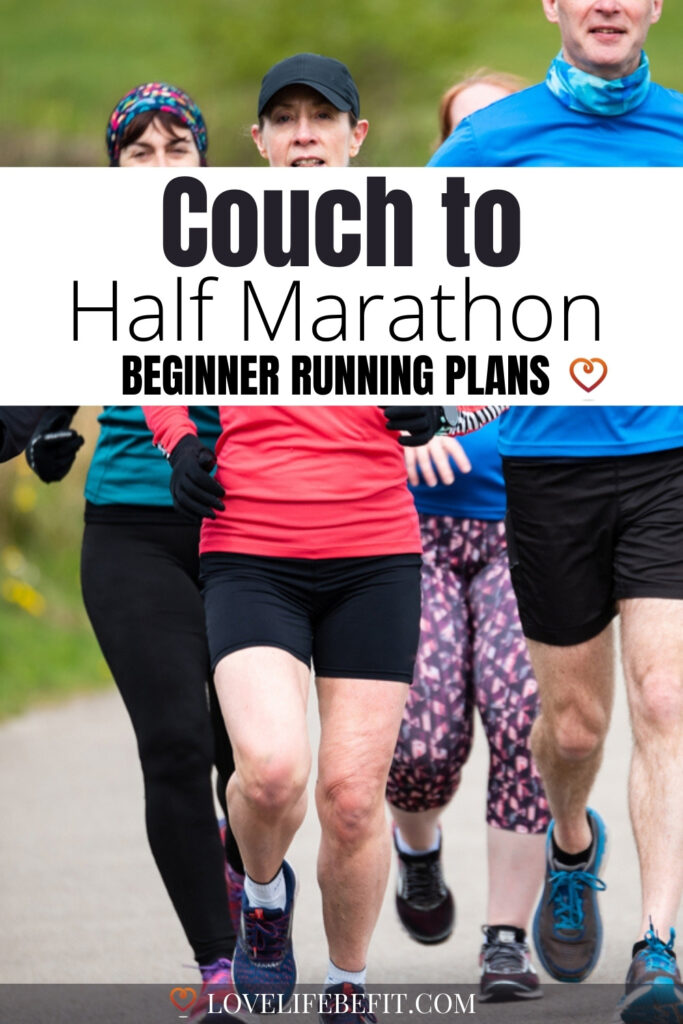Couch To Half Marathon: The Ultimate Training Plan For Beginners
Let me guess, you’ve signed up for a half marathon. Maybe it was a bet, a selfless act to raise money for charity, or a big wake-up call to go from couch to half marathon via a life-changing journey.
Whatever the reason, tell yourself you can do this. All it takes is commitment, time, and of course effort. This isn’t 5k. A half marathon is a big deal – treat the challenge with respect!
But it’s not all about pain, sacrifice, and hard work. Training for a half marathon can be a lot of fun. You’ll see improvements in your fitness and energy levels and feel so much better about yourself.
Following this half marathon training schedule will add structure to your training and get you in the best possible shape for race day. Steady progress without over-training. Celebrate the small wins as you go from sitting on the couch to starting to run.
Find answers to all the big questions and learn how to adapt this couch to half marathon training plan to make it uniquely tailored to you and your running capability.
Advice such as:
- How to start training, even if you’re a beginner.
- The different elements of training – from long runs to rest days, cross-training, and fartlek.
- How to use easy weeks to rebuild and become a better runner.
- Finding the right running shoes to help you stay injury-free
- Preparing for race day – everything from race pace to refueling.
A half marathon is 13.1 miles or 21.1 km. It’s a significant distance and a great challenge for any new runner.

How Long Does It Take To Train For A Half Marathon From Couch?
The training plan included at the end of this post is for new runners and takes 16 weeks to go from couch to half marathon. It’s a training program for a complete beginner runner.
That might sound like a long time, but the aim is to build your beginner half marathon training steadily and consistently – so you become a strong injury-free runner.
Doing too much too soon is the main reason beginner runners fail to get to the starting line of their first race!
Can You Go From Couch To Half Marathon In 12 Weeks
I get it, I really do. You meant to start training for your half marathon months ago and now race day is only 12 weeks away.
If you’re reasonably young, not carrying too much excess weight, or you’re fit from other sports, it’s possible to complete your first half marathon on the back of a 12-week training plan.
For this reason, I’ve included a 12-week version of my half marathon training plan at the end of this post. Follow the training schedule with some caution and take extra rest days if you need them.
It’s a good training schedule for an experienced runner returning from a lay-off or injury.
The aim is to get to the start line in one piece. You can always take a few walking breaks during the race and still complete your half marathon.
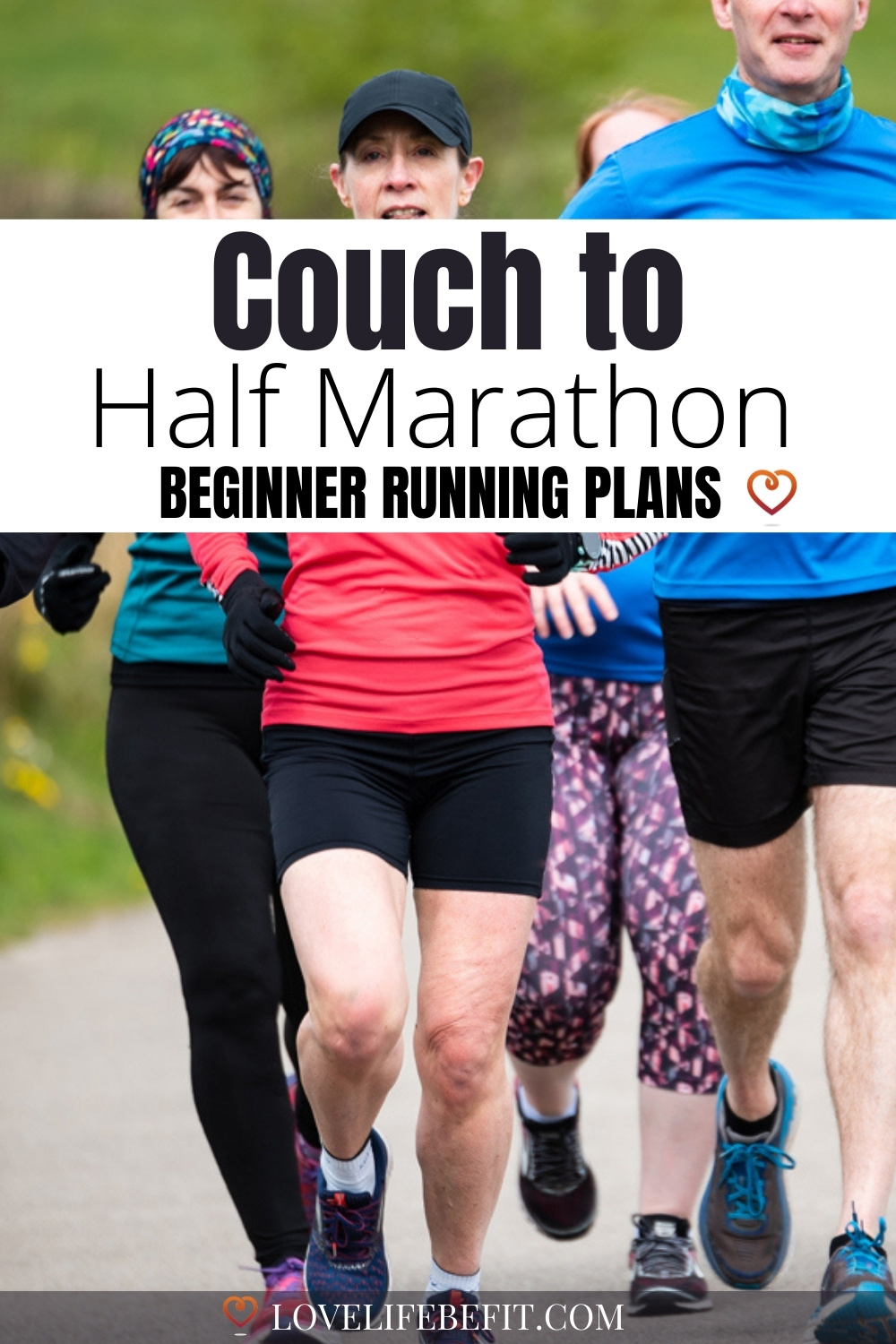
How Fit Do You Need To Be To Start A Couch To Half Marathon Training Plan?
The half marathon plan starts from zero with run/walk sessions where you alternate running and walking – gradually increasing the run intervals. It eases you into running.
The first target on your half marathon journey is a 5K race. (You don’t need to enter a race – just completing a timed 5K will do but it’s so much better to enjoy the excitement and challenge of a race).
However, this isn’t your standard Couch to 5K build-up. It’s faster with 4 to 5 training days per week.
It’s better if you start the program with some existing fitness. Maybe you walk regularly or take part in another sport. If you can already run for 5 minutes continuously, you’ll find this training program a lot easier to follow.
If not, be prepared to repeat training weeks as necessary. It’s better to take longer to build up to running a half marathon than push yourself too hard.
NOTE: If you haven’t exercised in a long time please check in with your doctor before starting the program.

The Building Blocks Of A Successful Half Marathon
It takes more than just doing a bit of running to complete a half marathon. At least for most people.
There’s always one or two people who will vocally tell you they rolled out of bed one day and ran a half marathon or even a marathon. The pop duo Jedward famously did it and I’ve even done it myself! It helps if you’re young, reasonably fit, and run at a very easy pace.
For most people, it’s always a good idea to train properly. Following a half marathon training plan will get you to the finish line in the best possible shape. Hopefully injury-free and fired up to enter another race.
Training plans give your runs a purpose. They give you the building blocks to improve your fitness level and get used to running longer distances. See your performance improve week by week as you become a stronger, fitter runner with more resilience to injuries.
#1 Start With The Run/Walk Method
When you start running for the first time, it can seem really hard. So this couch to half-marathon running journey starts with easy run/walk intervals.
You run a little, walk a little. Gradually the running intervals get longer and the walking intervals become shorter until you’re running continuously. It’s a bit like tricking your body into running!
The run-walk method makes running for beginners much easier. This training schedule uses it for the first 5 weeks until you’re able to run your first 5K.
Once you’ve learned the run/walk method it’s a tool you can always fall back on if you’re struggling during a long run or race. I’ve used this method in the latter stages of a marathon and still recorded a respectable time. It’s often better (and faster) than trying to struggle along with poor running form when your legs are really tired. Here are some more running tips for beginners.
#2 Get Some Good Running Shoes
You can get away with just about anything when it comes to running clothing but good shoes are essential. They need to be the right shoes for you.
The best place to buy running shoes is at a specialist running store. Find a local one with experienced staff who can talk you through all the different types of shoes.
Try on lots of pairs and make sure they feel comfortable. If they don’t feel comfortable right out of the box, they definitely won’t over a half marathon distance!
Overweight runners and heavy runners will be at greater risk of running-related injuries – so it’s even more important to buy the right running shoes for overweight runners.
When it comes to clothing, the only essential item is a good sports bra for women. However, a few pairs of specific running socks will help keep you blister-free and you’ll be a lot more comfortable wearing breathable wicking tops and shorts. Here are my favorite picks for women’s running clothing.
#3 You Don’t Need A GPS
You can complete all these half marathon training plans using a free running app on your phone to time yourself and measure distance. Map My Run is one of the most popular free apps.
A GPS isn’t necessary.
As you become serious about your training, I’m sure you’ll end up buying one. They’re terrific for analyzing your performance and running pace. But this is your first half marathon. The aim is to get you to the finish line of your half marathon at a comfortable pace.
This is the base building phase for your running. A time to build endurance and baseline strength. The aim is to run consistently and for that, you don’t need a GPS. Speed work, strength training, and focusing on performance will come later – leave it for your next half marathon when you can work on improving as a runner. Right now we’re following a Couch to Half Marathon training program.
#4 Slow Down
Nearly all new runners try to run too fast. They think the only way to get better at running is by trying to run faster.
That’s not true!
You improve your running by slowly increasing the volume of training you do, (how far you run), and by slowly adding in some quality workouts, (tempo runs, intervals, fartleks).
As a new runner, your body has a lot to cope with! Even easy runs put a lot of stress on your untrained body. The last thing you need right now is hard training and overload.
Instead, a golden rule is to complete your training runs at a conversational pace. An easy run. You should be able to chat away with your friends (or yourself!) without getting out of breath. It’s running at a perceived exertion of 3 or maybe 4 on the RPE Chart.

#5 Running Form
There’s a big argument for not messing with your running technique. Running form is a hot topic but just because most elite athletes have excellent running styles, it doesn’t mean the rest of us should try and copy them.
These athletes are much stronger and fitter. Plus all runners are different with individual unique geometry. What works for one runner might not work so well for another.
Still, if you feel you’ve completely forgotten how to run and lost all your natural instinct – here are a few running form tips.
#6 Long Runs
16 weeks or even 12 weeks might sound like a long time but in the journey of a new runner, it’s really not that long. The focus of these half marathon plans is to get you over the finish line and that means long runs.
For your beginner half marathon training program, the long run is key. After the first 5 weeks, we introduce weekly long runs into the training program.
This will be easy running. The aim is to complete the distance comfortably. If you find yourself struggling, adopt the run/walk method for a short distance until you’re able to run consistently again.
For longer runs make sure you have plenty of fluids with you and take gels to refuel if necessary. Refueling is important for any runs longer than 90 minutes.
The longer runs increase in distance gradually every week before you hit the final two-week taper period. On the 16-week half marathon training plan, the longest run before your half marathon race is 11 miles. For the 12-week plan, it’s 9 miles.
This will be enough to get you over the finish line, but if you’re following the 12-week schedule you may need to take a few walking breaks. For most runners, the adrenaline of competing in a race will keep you going.
#7 Cross Training
It’s never a good idea to increase your weekly mileage too fast or add too many extra miles each week to the length of your long run. The golden rule is to never increase weekly mileage by more than 10%.
You’ll quickly find that running is quite a repetitive exercise. It’s good for your cardiovascular fitness but can lead to injuries if you don’t cross train and give your body a break from the pavement pounding.
Aerobic cross training activities such as swimming, cycling, rowing, or elliptical training are all excellent alternatives to running. They’re low-impact but good cardio workouts.
The couch to half marathon training plan adds one cross training workout each week to build your fitness but gives you a rest from running. Any aerobic activity you enjoy is suitable.
#8 Fartlek
Your first half marathon training plan isn’t the place to start adding speed sessions or think too much about running faster. Right now we’re building a running base. So what is fartlek and why is it part of the couch to half marathon training plan?
Fartlek is a type of speed training that is good for beginners. Fartlek is a Swedish word meaning speed play. It’s where you run to feel.
Instead of running at a constant pace, you mix things up by running a little faster for a few minutes and then dropping the pace again.
Put the emphasis on play! Fartlek should be fun. Tune into your body and run a little harder. When your body has had enough, slow right down and take it easy.
It’s best to run Fartlek on soft surfaces so there’s less impact on your joints when you’re running faster. Find paths in your local woods or parks.
#9 Tempo Runs
There are different ways of using tempo runs depending on why you’re using them, but the main aim is running consistently at a specific planned intensity.
This half marathon training plan uses them to help you get a feel for your race pace. Rather than do all your runs at an easy pace, you can use your tempo runs to get an idea of running paces.
The tempo runs can either be 5K park runs where you’re running against other people or a timed 3-mile run. The important thing is to try and run at your target half marathon pace.
If you don’t have a target pace, try and run at a pace you think you can maintain for the half marathon distance. That’s a challenging pace – level 6 on the RPE chart.
It’s going to be about 1 min/mile slower than your 5K race pace.

#10 Rest & Recovery
Rest and recovery are important to avoid the risk of injury.
You’re fitting in several running workouts a week plus a cross training day – that’s a lot of hard effort. Recovery days are important for injury prevention and help your body prepare for your next workout.
As the training progresses, don’t be surprised if there are times when one day of rest isn’t enough. We all have bad weeks where we need a little extra R&R. So if you need it – take an extra day off and recover.
Watch out for DOMS – delayed onset muscle soreness. It can strike when you push yourself a little too hard. So if your legs are sore – rest and recover instead of trying to keep running on tired legs.
Recovery tips:
- Eat a carbohydrate and protein-rich snack within 30 minutes of completing your run. Aim to consume 1.2g of carbohydrate per kilogram of your body weight (kg/bw) and up to 0.4g of protein per kg/bw. Peanut butter bagels are my go-to recovery snacks!
- Foam rolling and stretching after each session can help prevent sore muscles.
- Avoid alcohol if you’re dehydrated, (it’s a good idea to cut back when you’re training), and make sure you drink enough fluids during and after your runs. Be aware of the risks of overdrinking – hyponatremia and only drink to thirst.
- Get lots of sleep!
#11 Tapering
Both training plans include a two-week tapering period. This is a chance for you to get lots of rest and be in the best possible shape for your race!
You’ll peak with your longest run at the end of your highest mileage week – 14 days before your race.
The taper period lets you capitalize on your training peak. You’ll maintain the same level of fitness but give your body a chance to recover. The aim is to be fully fit and rested for your race.
#12 Race Day
This isn’t a 5K race that’s over in 30 or so minutes. Most beginners can expect to run for 2 plus hours. You’ll need to refuel and hydrate during the race.
Race organizers will provide drink stations but you may need to carry your own gels.
Allow plenty of time to get to the start – especially if it’s a big race – and be prepared for long toilet queues!
Warm up before the race. Often race organizers will lead you through a group warmup before the race starts. Make the most of it!
Try not to set off too fast. Ignore other runners and run at your own pace. Don’t stress about your running performance on the day. Even if you’re the last person in the race, you’re still out there making the effort – and I’m sure you’ll get the biggest cheers at the finish line of the half marathon.
Try and enjoy yourself – this is your big day and you’ve trained hard! These first half-marathon tips will help you prepare for race day!
Couch To Half Marathon Training Schedule
The 16-week training plan is split into 3 sections:
- Couch to 5K
- 5K to 10K
- 10K to Half Marathon.
16 Week Couch To Half Marathon Training Plan
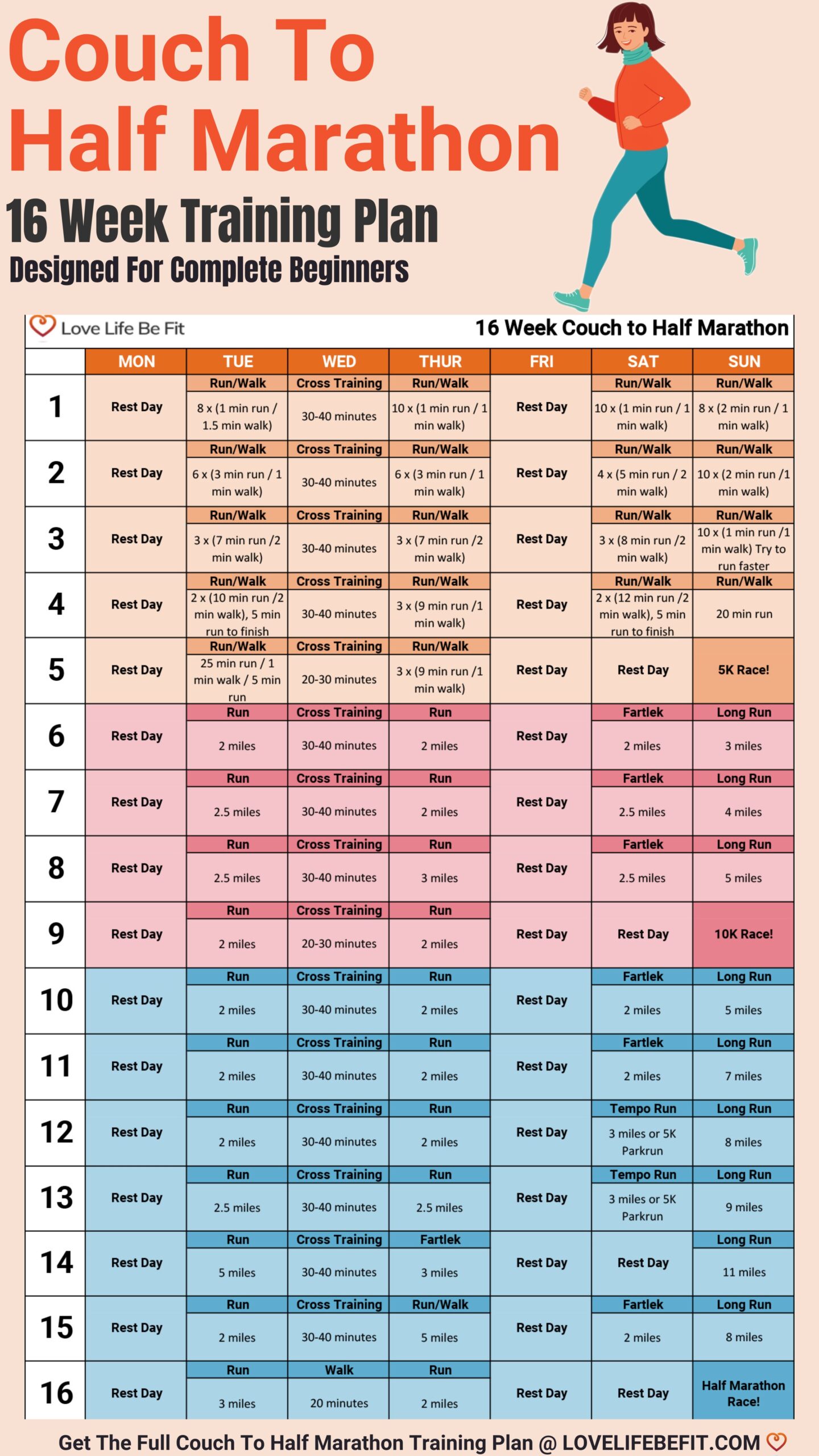
It’s recommended that you mark the end of each stage with a race – 5K, 10K, and finally, at the end of 16 weeks, a half marathon.
You can of course take longer, adding extra weeks between each section, but try and keep up your running rather than losing your fitness.
Start each training session with a warmup. For Couch to 5K training, this should be 5 minutes of brisk walking. For the later sections, you can replace brisk walking with a very easy run.
12 Week Couch To Half Marathon Training Plan
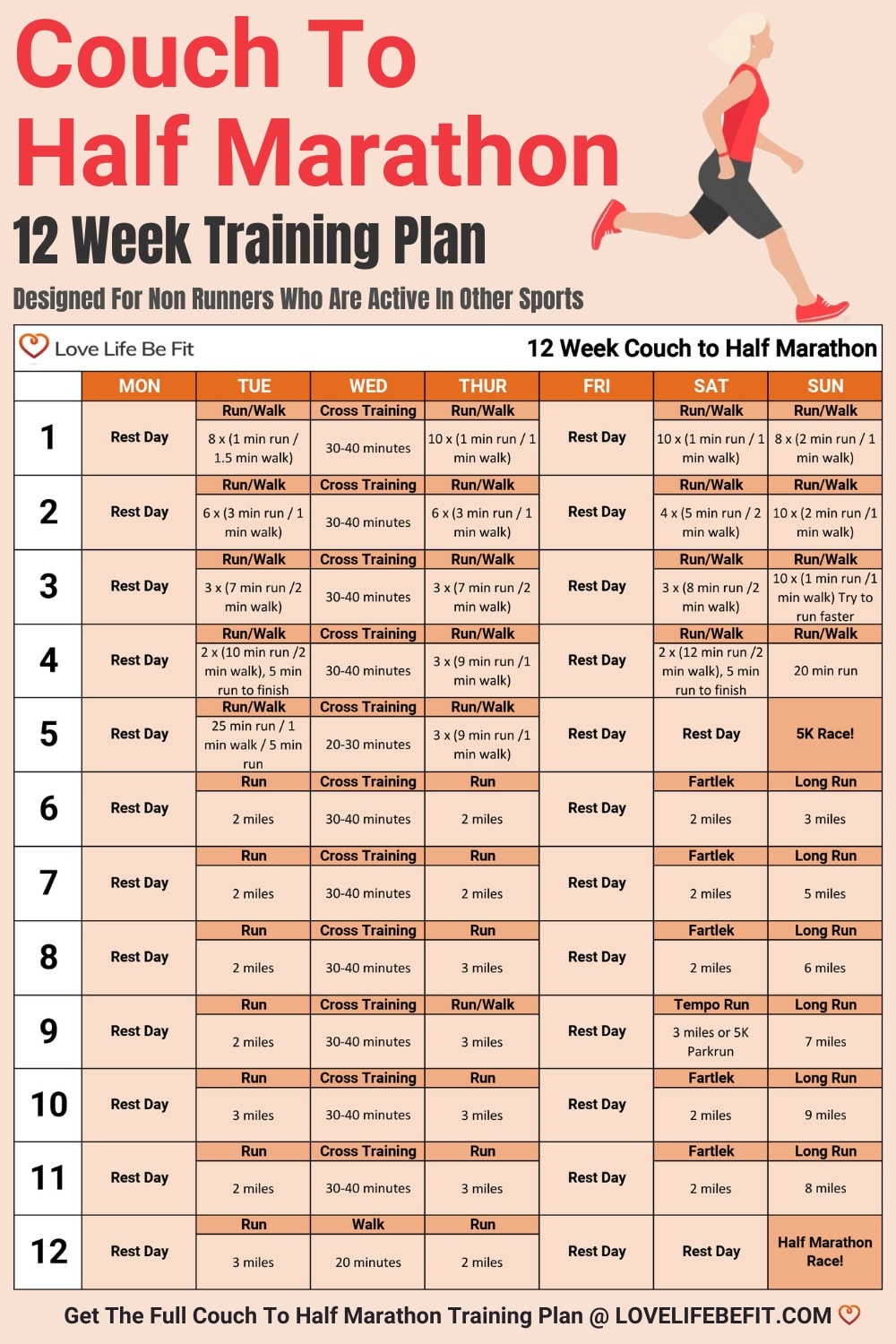
The 12-week training plan follows the Couch to 5K plan for the first section then jumps from 5K to half marathon for the second and final section.
There isn’t time to run and recover from a 10K race. Instead, the focus is on the half marathon goal.
Couch To Half Marathon Training Schedule
Here are a few notes on each section:
Couch To 5K
This Couch to 5K training plan lasts 5 weeks. The focus is on run/walk intervals with one cross training session per week.
It’s a fast build-up if you’re a complete couch potato and haven’t exercised in years, and some people will be better off following a standard 9-week plan.
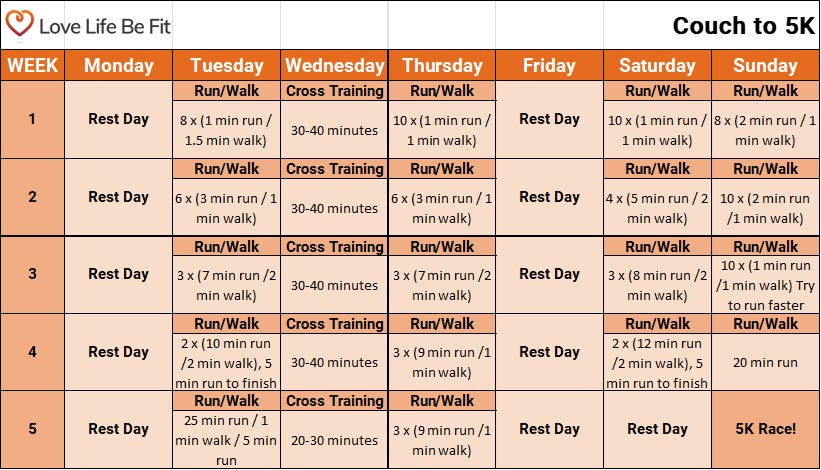
5K to 10K – 16 Week Schedule
There are no more run/walk sessions. We introduce your weekly long runs and fartlek. It’s a 4-week build-up to a 10K race.
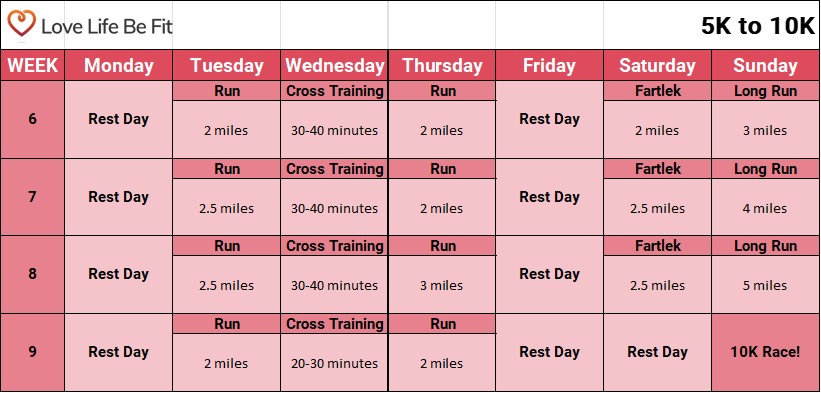
10K to Half Marathon – 16-Week Schedule
This builds on your 10K training with gradually increasing long runs, more fartlek sessions and a few tempo runs to give you a feel for race pace.
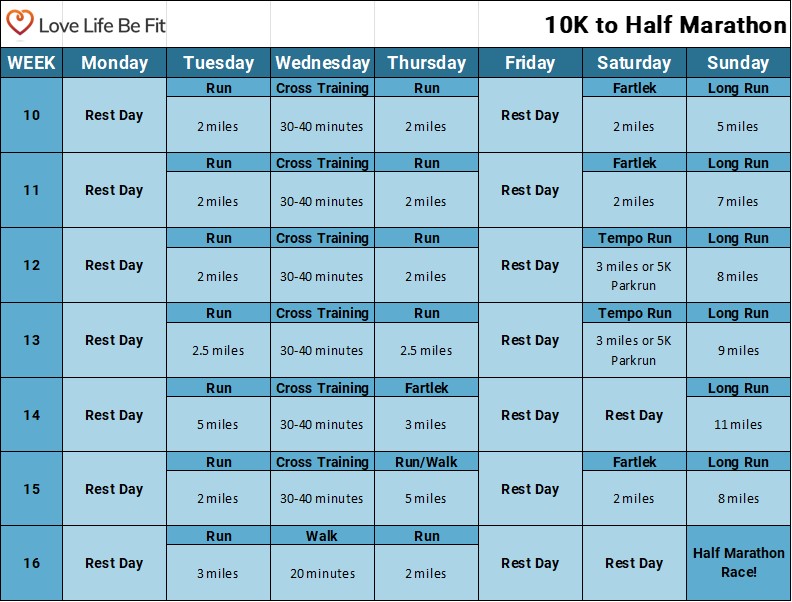
12-Week Training Plan
This follows the same Couch to 5K in 5 weeks plan, then goes straight from 5K to half marathon.
It’s going to be tough – so only try this plan if you’re super confident, already fit from another sport – or you’re fully committed to a half marathon race and you’ve only got 12 weeks left to train!
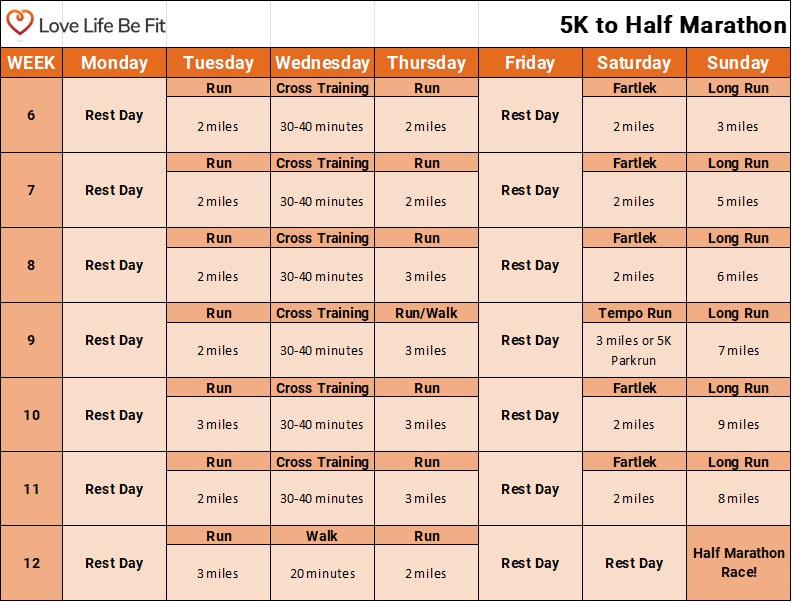
Running 101 Training Guides & Walking Schedules
5K Training Plans
- Couch To 5K Beginner Training Plan
- 12 Week 5K Training Plan
- 10 Week 5K Training Plan
- 8 Week 5K Training Plan
- 6 Week 5K Training Plan
- 4 Week 5K Training Plan
- 5K Training Plan Intermediate

